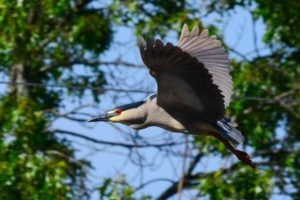
Given all that York Pond by the Seekonk River has been through at the hands of humans, well-intentioned and not, in the last few centuries, you might not expect to see much movement there. But on a morning this May it throbbed with life! Five egrets flew up to roost in trees at water’s edge, ducks splashed and eight snapping turtles lumbered nearby. Two different species of herons came and went, using plants for sustenance and shelter that the Blackstone Parks Conservancy (BPC) installed over a decade ago at the water’s edge.
Now burdened by street sand and pollutants, York Pond used to resemble Grotto Creek just to the north, an open-mouthed inlet where fresh water and bay water sloshed back and forth. Old underground streams drained a 380-acre east side watershed through the five-acre ravine lush with ferns and wildflowers that Moses Brown’s grandson donated to the City in 1866. The streams still flow, but instead of meandering at their own pace and nourishing the narrow valley, they race straight through the hard-lined waterway installed in the 1930s by the WPA (Works Progress Administration), surging during rainstorms.
Water engineers today recognize that nothing is simple where flowing water is concerned. Whereas earlier engineers tried to move stormwater out of settled areas as fast as possible, current experts (hydrologists) aspire to mimic nature, allowing water to penetrate the ground close to where it falls.
The Environmental Protection Agency (EPA), Department of Environmental Management (DEM), BPC, and the city of Providence dredged York Pond, which had become an unsightly dump by the end of the 20th C, with welcome results. However, the dissipator, a concrete holding barrier installed at the back of the pond to capture street sand and trash was poorly built and improperly maintained, and the pond regressed toward its degraded state.
From idyll to dump for toxic waste to skating rink and back again, the pond’s history illustrates the dilemmas and opportunities confronting the city and the BPC as they seek to preserve and protect Blackstone Park for all to enjoy. With the help of state environmental agencies and Rhode Island scientists and engineers, the BPC has made real progress in the Blackstone Park Conservation District by working with adults and children to protect plants and soil from stormwater runoff and invasive plants. Grants from the Coastal Resources Management Council (CRMC) are particularly helpful in retaining soil on steep slopes.
The most formidable challenge in the Conservation District may be figuring out how to correct York Pond’s imbalances. This, the BPC hopes to do in future partnership with the Seekonk Riverbank Revitalization Alliance and all the city offices and agencies and non-profit groups who see value in protecting water bodies for recreation.
The opportunities for recreation and simple pleasure at York Pond are many. Even now, the historic pond remains a quiet spot for wonder–the “shower of white fire” made by the egrets in Mary Oliver’s poem–and inspiration. Easels perched at pond’s edge, books and notepads in the hands of readers, people simply relaxing on park benches nearby all attest to the influence of this water. And students of all ages learn from York Pond.
Here nature is resilient. And the job of the community led by the BPC is to boost that resilience. We do this with volunteers and your donations.
Jane Peterson



